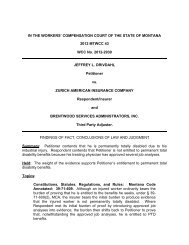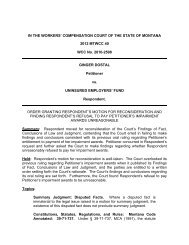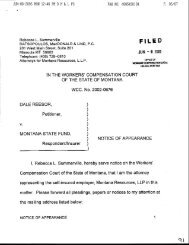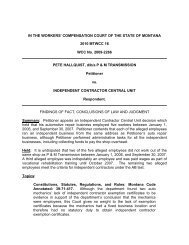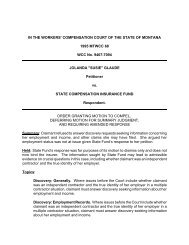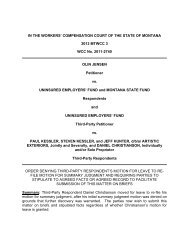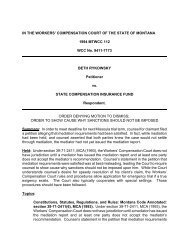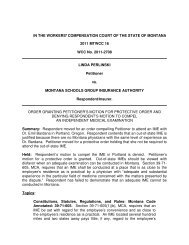Order Resolving Respondent's Motion in Limine and Findings of ...
Order Resolving Respondent's Motion in Limine and Findings of ...
Order Resolving Respondent's Motion in Limine and Findings of ...
Create successful ePaper yourself
Turn your PDF publications into a flip-book with our unique Google optimized e-Paper software.
CONCLUSIONS OF LAW 52 An employee’s last day <strong>of</strong> work is the po<strong>in</strong>t <strong>in</strong> time from which an occupationaldisease claim must flow. 76 Clapham’s last day <strong>of</strong> work with Crown Parts was onNovember 24, 2010. 77 Therefore the 2009 statutes apply. Clapham bears the burden <strong>of</strong>prov<strong>in</strong>g by a preponderance <strong>of</strong> the evidence that he is entitled to the benefits heseeks. 78ISSUE ONE: Whether Petitioner suffered a compensable occupational disease <strong>in</strong>his employment with Crown Parts pursuant to §§ 39-71-407(9) <strong>and</strong> (10), MCA. 53 An “occupational disease” is harm, damage, or death aris<strong>in</strong>g out <strong>of</strong> or contracted<strong>in</strong> the course <strong>and</strong> scope <strong>of</strong> employment caused by events occurr<strong>in</strong>g on more than as<strong>in</strong>gle day or work shift. 79 An occupational disease is considered to arise out <strong>of</strong>employment or to be contracted <strong>in</strong> the course <strong>and</strong> scope <strong>of</strong> employment if: (a) theoccupational disease is established by objective medical f<strong>in</strong>d<strong>in</strong>gs; <strong>and</strong> (b) the eventsoccurr<strong>in</strong>g on more than a s<strong>in</strong>gle day or work shift are the major contribut<strong>in</strong>g cause <strong>of</strong> theoccupational disease <strong>in</strong> relation to other factors contribut<strong>in</strong>g to the disease. 80 “Majorcontribut<strong>in</strong>g cause” is the lead<strong>in</strong>g cause contribut<strong>in</strong>g to the result when compared to allother contribut<strong>in</strong>g causes. 81 54 Under § 39-71-407(10), MCA, when compensation is payable for an occupationaldisease, the only employer liable is the employer <strong>in</strong> whose employment the employeewas last <strong>in</strong>juriously exposed to the hazard <strong>of</strong> the disease. 55 In Montana State Fund v. Gr<strong>and</strong>e, 82 the Montana Supreme Court affirmed thisCourt’s decision <strong>and</strong> set forth its <strong>in</strong>terpretation <strong>of</strong> § 39-71-407, MCA (2009). The courtnoted that it is unlikely that the only contribut<strong>in</strong>g factor to an occupational disease wouldbe the employee’s job duties, <strong>and</strong> noted that for an occupational disease to becompensable under the Workers’ Compensation Act, it need only be “the lead<strong>in</strong>g cause76 Flem<strong>in</strong>g v. Int’l Paper Co., 2008 MT 327, 27, 346 Mont. 141, 194 P.3d 77.77 Amended Petition for Hear<strong>in</strong>g, 8, Docket Item No. 22.78 Ricks v. Teslow Consol., 162 Mont. 469, 512 P.2d 1304 (1973); Dumont v. Wickens Bros. Constr. Co.,183 Mont. 190, 598 P.2d 1099 (1979).79 § 39-71-116(20)(a), MCA.80 § 39-71-407(9), MCA.81 § 39-71-407(13), MCA.82 Gr<strong>and</strong>e, 2012 MT 67, 364 Mont. 333, 274 P.3d 728.<strong>Order</strong> <strong>Resolv<strong>in</strong>g</strong> Respondent’s <strong>Motion</strong> <strong>in</strong> Lim<strong>in</strong>e <strong>and</strong>F<strong>in</strong>d<strong>in</strong>gs <strong>of</strong> Fact, Conclusions <strong>of</strong> Law <strong>and</strong> <strong>Order</strong> - 16


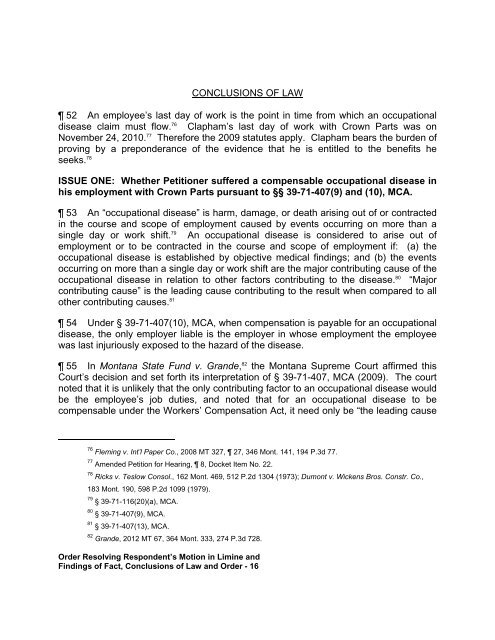
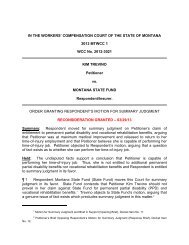
![Bustell v. AIG Claims Service, Inc. [05/03/05] 2005 MTWCC 23](https://img.yumpu.com/49777654/1/190x245/bustell-v-aig-claims-service-inc-05-03-05-2005-mtwcc-23.jpg?quality=85)
![Vallance v. MCCF [07/05/06] 2006 MTWCC 26 - Workers ...](https://img.yumpu.com/48724322/1/190x245/vallance-v-mccf-07-05-06-2006-mtwcc-26-workers-.jpg?quality=85)
